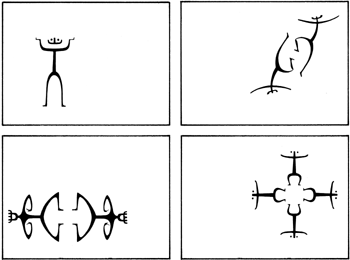![[Metroactive Movies]](/movies/gifs/movies468.gif)
[ Movies Index | Show Times | San Jose | Metroactive Central | Archives ]
 It Figures: Animator Philip Stapp uses deceptively simple drawings in his work, such as these graceful stick figures from his 1966 film, 'Symmetry.' Stapp Animation Cine 6 hosts a night of features by unsung animator Philip Stapp WHEN YOU SEE ONE of Philip Stapp's short films, you wonder where he's been all your life. He's probably the most reclusive of the talents unearthed for the continuing shows at cine16. "You could say his career is all about being unknown," says cine16 host Geoff Alexander. "Getting his films is a real coup for us." Stapp, born in 1908, was one of President George Bush's teachers at Connecticut's Greenwich Country Day School. After a period overseas, Stapp worked at Bennington College with the choreographer Martha Graham on her Every Soul Is a Circus performance. Over the last few years, Stapp's work has been confined to scrolls that need to be viewed in a specially designed chair, ensuring that only one viewer at a time can look at his art. Cine16 is presenting a one-night-only festival of Stapp's unusual animated films, mostly from 1945 to 1980. Though the artist worked within the realm of educational and public-service films, he created animation that is free of even the slightest didactic quality. His disturbingly abstract work transforms commonplace messages such as "Watch your blood pressure" and "War is bad" into personal statements. Boundary Lines (1946) could have only been made in that short gap between the end of WWII and the beginning of the Cold War. The animated short delivers a beyond-borders message with its discussion of the human concept of the dividing line and how it leads to envy and destruction--compared to the all-inclusive circle that could be drawn around humanity. Simplistic? Perhaps, but the unsparing power of Stapp's images is something you've never seen in this kind of message film. During the 1950s, Stapp "sort of went underground," Alexander says. Then, in the 1960s--when public art had a looseness it will never recover--Stapp hit his stride. The First Americans (Part 1): And their Gods (1969) gives a quick outline of Mesoamerican history. Stapp uses tropically colored images reminiscent of Mexican murals and Aztec/Mayan sculpture to illustrate a text of secular humanism and cultural relativism fit to drain the blood out of a senator's face. "How can we understand what dying meant to them?" asks the narrator, dealing with the thorny topic of human sacrifice. Stapp's animation uses a transfer process, embossing images of colored chalk onto white-charcoal covered paper. It's hard to imagine a more obsessive or unforgiving medium, but Stapp's cartoons have the advantage of snowflakelike delicacy. In Symmetry (1966), Stapp explains through art (and through the music of Gene Ferrell) the concept of bilateral symmetry, found in most living beings and observable through the abstract patterns shown here: crystals that melt and coalesce into patterns that look like the lively squiggles of a Miro drawing. Stapp's last film, made for the American Heart Association, is A Game of Chance, a calm sort of warning about too many cigarettes, too much steak and eggs, made by doctors from 1979 who didn't feel the need to scare the bejesus out of the public. Unfortunately, Stapp won't be in attendance at this impromptu film festival. As for the artist's whereabouts, Alexander says, "He moved to Phoenix--and no one, not even his closest friends knows where he is. That's Philip!"
Cine16 presents the films of Philip Stapp on Thursday (July 27) at 9pm at the outdoor plaza of the Agenda, 399 S. First St., San Jose. Admission is free. [ San Jose | Metroactive Central | Archives ]
|
From the July 27-August 2, 2000 issue of Metro, Silicon Valley's Weekly Newspaper.
Copyright © 2000 Metro Publishing Inc. Metroactive is affiliated with the Boulevards Network.
For more information about the San Jose/Silicon Valley area, visit sanjose.com.